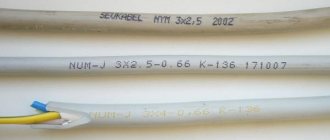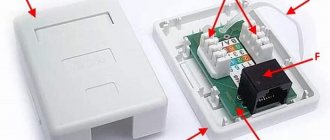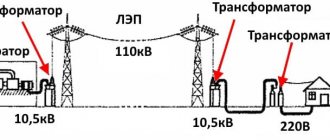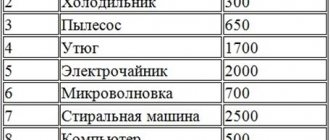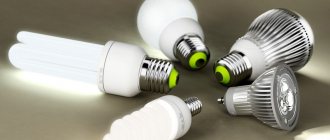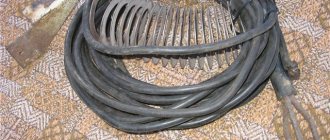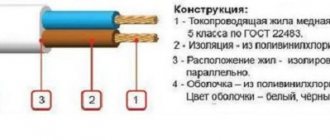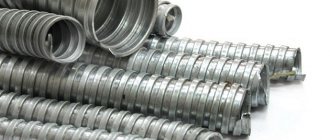To connect new household equipment or make high-quality extension cords (surge protectors), ShVVP wire is most often used. Cords are made from it for most types and models of household appliances.
At more powerful production facilities, for powering consumers in high-voltage electrical networks, preference is given to other analogues. Only in rare cases can it be used to arrange a temporary power line.
Explanation of the name of the SHVVP wire
The Russian-language marking of the SHVVP wire is deciphered quite simply. With its help you can get a brief description of the electrical installation product:
- The first thing you need to pay attention to is the absence of the letter “A” at the beginning of the abbreviation. By its presence or absence in the designation of any cable, one can judge the material of the cores - aluminum or copper, respectively. And SHVVP is a copper conductor.
- The letter “B” indicates that the core insulation is made from high-quality polyvinyl chloride.
- The second letter “B” indicates a similar material for the manufacture of the outer shell, under which all the cores are hidden at once.
- The letter “P” means that the ball screw cord is flat (all cores are arranged in parallel, regardless of the number).
Important! Despite the flat structure of the wire, the cores can be twisted into various rounded shapes.
This cable is often modified and improved. The appearance of one or another useful quality must be indicated in the labeling. For example, the symbols “ng” can be added to the SHVVP through a hyphen. They say that the insulation material does not support combustion. The prefix from the Latin letters LS means that during the combustion process the insulation emits a minimal amount of smoke and harmful substances.
Design
Considering the design features of the SHVVP cable, three main points can be distinguished:
- the composition includes several wires insulated from each other, consisting of many thin wires;
- all cores have a round cross-section;
- There is general insulation made of PVC plastic.
It was written above that the veins, regardless of the number, are arranged in parallel. By the color of the insulation of each core you can judge what it is intended for:
- the blue sheath indicates the neutral wire;
- yellow-green – grounding;
- brown or red – phase.
Two-core cables are often produced in which there is no possibility of grounding.
This is interesting! Often, manufacturers of electrical (in particular, cable) products produce ball-type conductors with copper-aluminum conductors. In this case, the quality of electrical signal transmission deteriorates, but the cost of the final product and, accordingly, electrical installation work decreases.
Types of SHVVP wire
There are several main criteria used to classify CVVP:
- cross-sectional area of the current-carrying conductor;
- their number;
- product color.
We list the main variations of this cord depending on technical and operational parameters:
- The corresponding clause of GOST strictly defines the permissible values of the cross-sectional area of the SHVVP conductor - 0.5 or 0.75 square meters. mm. If you find a cable of a different cross-section in a store, then you should know that it is not provided for by domestic standards, but can still be used (certificates are not issued for such products). Depending on the number of current-carrying cores, two- and three-core cables are produced. Let us repeat that 0.75 sq. mm is the cross-sectional area of one of them.
- The core consists of several wires twisted together, which provides increased flexibility of the product. In accordance with GOST, their number must be at least seven pieces. The diameter of the wire in the SHVVP cord with a core cross-section is 0.5 square meters. mm is 0.33 mm, 0.75 sq. mm – 0.38 mm.
- Regardless of the specific values, the thickness of the insulation on each core must be at least 0.5 mm, the outer sheath - from 0.6 mm and above.
- It was written above about the color difference of the ball-and-ball cord. In most cases, the outer sheath of the cable is white, but some manufacturers produce products in black. The coloring of the outer protective layer does not affect the pricing policy and does not indicate better or worse technical and operational parameters.
Characteristics
We list the main features of this product:
- consists of two or three conductors laid in parallel, each hidden in a durable PVC sheath;
- all cores are multi-wire (no monolithic cords);
- flexibility class – 5;
- the shell is made of polyvinyl chloride;
- voltage – 220/380 V;
- cable cross-sectional area – 0.35-2.5 sq. mm;
- operating temperature range – from -40 to +40 degrees. Celsius;
- rated current value - calculated in accordance with the cross-section and number of cores.
Mechanical properties
The greatest contribution to the popularity of the SHVVP cord was made by its mechanical characteristics, so the wire is used where increased demands are placed on them:
- ShVVP has unsurpassed flexibility, as indicated by the minimum bending radius - 5 outer diameters of the wire. Since the cable is flat, in the calculations it is enough to use the minimum thickness of the product, so none of the conductors can compare with it in terms of flexibility.
- During the manufacturing process of ball screws, they try to ensure high resistance of the product to repeated bending and extension. Usually up to 30,000 such cycles are laid.
- Despite this, such actions will sooner or later affect the technical parameters of the product. Manufacturers warn consumers that if exposed to constant bending and straightening, the service life of the wire is reduced to two years. In normal mode it is 10 years.
- It is noteworthy that when undergoing technical tests, the wires are checked not only for bending, but also for tension. In accordance with GOST, the ShVVP cable can withstand up to 9.8 N of pulling load, without causing any visible damage. During this test, the cable sheath is removed.
- Before being sent to store shelves, the cord is tested in a special chamber at a temperature of +80 degrees. Celsius. He stays there for 90 hours. Upon completion of this process, wait another two to three hours until the conductor cools completely, after which they make sure that there are no visible defects.
- The test of ball-and-pressure balls at low temperatures looks much tougher. The cooled cord is pulled under a roller with a cross-section equal to four outer diameters of the cable. The wire is then tested for shock resistance. A valid product is considered to be one that has passed all of the above checks and is not damaged.
- In the standard version, the operating temperature range is from -25 to +40 degrees. Celsius. Above, we indicated increased limits that are relevant for ball-type conductors in special climatic versions. Regardless of the operating conditions when using the cable, the temperature of one core should not exceed +70 degrees. Celsius.
Electrical properties
Ball screws would not be so popular without good electrical characteristics, which describe the efficiency of the main purpose of the product - passing current. Let's list the main points:
- The main electrical parameter of any wire is resistance. In accordance with GOST for ball screws with a cross section of 0.5 sq. mm at core temperatures up to 70 degrees. Celsius its value is at least 0.012 Mohm. For cable with a cross section of 0.75 sq. mm this parameter will drop to 0.01 Mohm. These figures may seem high, but it must be taken into account that the measurements were tested on a 1000 m wire.
- Another important characteristic is the insulation resistance. To obtain a specific value, you need to measure the insulation resistance between the core and the ground, as well as between two adjacent cores.
- To test the last parameter, take a piece of cord of a ball-and-pressure device with a length of at least 5 m. It is placed in water, then a voltage of 2 kV is applied and the leakage current values are measured.
- To check the insulation resistance between two adjacent conductors, take a piece of ball-type conductor with a length of at least 2 m. The sheath between the conductors is cut. The further process is similar - the cable is lowered into the water, voltage is applied, and the leakage current values are measured.
Decoding and types
The marking indicates the structure and design of the product. So, the SHVVP has the following decoding:
- Sh means it is a cord. Its main difference from classic wire is increased flexibility and good insulation. Conventional wires often come without internal insulation;
- B - indicates the insulation material, which is PVC plastic (polyvinyl chloride);
- B - means double insulation. Such a cord consists of several conductors at the same time, where the first insulating layer is on each of the conductors, and the other is the shell of the entire product;
- P - indicates the plane of the cord. In other words, the wire strands are parallel to each other, regardless of their number. In addition, the flat arrangement does not exclude twisting of the cores to give the cord a round shape.
Other factors that influence the characteristics of the product and divide it into different types are:
- Number of cores;
- Section;
- Cord color.
Based on this, there are various cord options that differ in their characteristics:
- According to current GOSTs, the cross-section of the cores of such a wire is either 0.5 mm or 0.75 mm. There are no larger options for the live parts of these cords;
Important! Today on the market there are various options with core cross-sections reaching up to 6 mm, but they are not standardized by the State Standards, based on which the listed characteristics do not apply to them.
- The maximum number of current-carrying wires used. According to current regulations, this type of brand can be either two-core or three-core. In both cases, conductors with a cross-section of up to 0.75 mm are used;
- Inside each core there are several wires. This is necessary to increase the level of flexibility of the cord. According to the current GOST, a SHVVP wire contains 7 or more copper wires. The diameter of each of them is 0.33 mm, if the core cross-section is 0.5 mm, and also 0.38 mm if this figure is 0.75 mm;
- Insulation thickness. Regardless of other characteristics, the insulation dimensions cannot be less than 0.5 mm. Moreover, the thickness of the shell is always greater than this indicator and amounts to more than 0.6 mm;
- Another characteristic by which SHVVP wires are distinguished is the color of the cores, as well as the sheath. Most often, the latter is made in classic white color, but if necessary, black coloring is used. As for the cores, they are made from a large color palette, the parameters of which are defined in the current GOST 7399–97. Coloring does not affect the cost of the wire.
Application of cords
ShVVP can be successfully used both in home and outdoor conditions. The maximum cross-section of non-standard cables does not exceed 2.5 square meters. mm, so they are not suitable for switching high power equipment, including heaters, electric kettles, workbenches, etc.
ShVVP is actively used in the following areas of life:
- electrical installation of lighting systems and small tabletop household appliances;
- production of extension cords and connecting carriers;
- connecting low-power household appliances (TVs, washing machines, computers, etc.) to an industrial electrical network with voltage up to 380 V;
- Can be used as an acoustic cable.
Important! You cannot use an extension cord created on the basis of a ball-type power supply for switching several low-power electrical appliances at once. Their values are added together and the final value may be excessively large, resulting in significant overheating and potential fire.
Where is it used?
This type of product is used for electrical installations inside buildings. Due to the small cross-sectional size, when using it, you CANNOT connect very powerful devices , which include:
- Heaters;
- Electric kettles;
- Various machines and heating equipment.
The main areas of application of SHVVP wire are:
- Ceiling lighting equipment or connecting various desktop equipment;
- Use as a carrier or extension cord;
- Connection of household appliances with a power of up to 1.3 kW, which includes: TV, washing machine (without dryer), computer, personal hygiene devices and others.
Important! You cannot install such wires throughout the house and connect all home appliances through them. This is due to the limited capacity of the 380 V cord. Connecting powerful devices will lead to a short circuit and fire. Due to this, electricians prefer to use PVA wires rather than SHVVP cords for wiring in an apartment or house.
Such cords have a carrying capacity of up to 380 V, a low level of resistance, but at the same time they bend well. Due to this, they can be used to connect household appliances and be used as an extension cord or carrying device. However, it is not suitable for connecting powerful equipment (more than 1.3 kW). Subject to compliance with the rules
Manufacturers
Among the domestic manufacturers of ball-type cords that have proven themselves among consumers and electricians, it is worth highlighting Sevkabel. The Verkhneoksky Cable Plant (VKZ) also produces good quality products. If you encounter a cable from other manufacturers and have doubts about the quality of the product, then use a caliper to determine the approximate thickness of the wire and calculate the cross-sectional area of the core.
Ball-type cords are a high-quality and inexpensive product suitable for temporarily connecting low-current household appliances to an industrial power supply network with a voltage of 220/380 V. Still, for stationary high-power installations, including machine tools and gaming computers, you need to use a cable with a large cross-section. Unlike SHVVP, the PVA cable can handle increased current load.
Also, when working with ball-type extension cords, constant monitoring and supervision must be ensured to prevent overheating and potential fire. If the temperature rises, the conductor needs to be replaced.
Characteristics
All characteristics that the ShVVP cable has are divided into mechanical and electrical, which should be considered separately.
Mechanical
This category of parameters has ensured great popularity for ball screw wires. This is due to the increased requirements placed on them:
- The main advantage of SHVVP is flexibility. The smallest bending radius is equal to 5 cord diameters, and due to the fact that it is flat, the diameter is determined by the minimum value;
- High resistance of the product to frequent bending due to a stranded copper core corresponding to class 5 flexibility;
- The SHVVP wire has a long warranty period of 10 years, while for conventional products this period is no more than 2 years;
- The maximum weight of a wire with a length of 1 km in a three-core version and a cross-section of 0.75 mm is 47.8 kg;
- High tension resistance. The SHVVP wire is capable of withstanding tension of up to 9.8 N, excluding the outer sheath;
- High temperature protection of the product, providing it with the ability to withstand prolonged high (up to 80 ⁰C) and low (down to –40 ⁰C) temperatures. However, the normal operating temperature of the wire is from –40 ⁰С to +40 ⁰С.
Worth knowing! Tests were carried out at high temperatures, reaching +80 ⁰С, as well as under various mechanical influences. If after this there was no damage to its surface, it was considered that the product had passed the test.
Electrical
Important parameters of the product are electrical. They determine its main operational properties that ensure conductivity:
- ShVVP cords, whose cross-section is 0.5 mm, at a temperature of +70 ⁰C have a resistance of 0.012 MOhm. For a thicker wire of 0.75 mm, these readings are equal to 0.01 MOhm;
Important! Resistance values are given for a cord 1 km long.
- The wire voltage frequency is 50 Hz;
- The maximum voltage of the SHVVP wires is 380 V;
- The failure-free operation time of such cords is 5000 hours;
- The maximum power of a ball screw cord with 3 cores and a cross-section of 0.75 is 1.3 kW;
- The current load of a core with a cross section of 0.5 mm is 3 A, and with a cross section of 0.75 - 6 A;
- Low level of insulation resistance. This parameter is measured in comparison between several cores and relative to the ground.
Worth knowing! The resistance of one core is tested on a product 5 meters long. It is lowered into water, after which a voltage of 2 kV is applied and the presence of leaks is checked.

